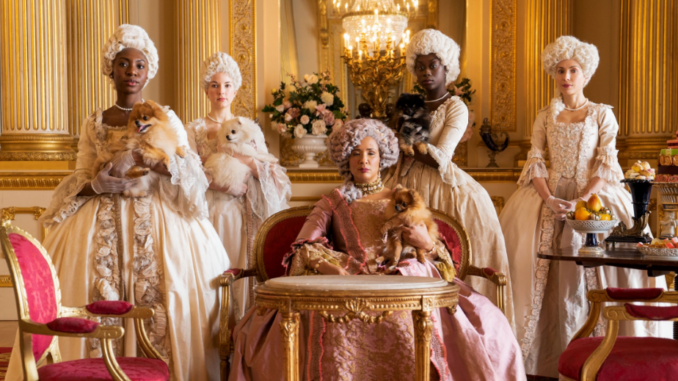
“Between the Armor and the Emotions: Queen Charlotte’s Journey in Bridgerton”
Welcome to the first installment of Bustling With Bridgerton, a series in which we celebrate and explore the costumes designed for Bridgerton’s most interesting characters: Queen Charlotte, Eloise Bridgerton, Penelope Featherington, and Cressida Cowper. Between the two seasons, costume designer John Glaser, along with associate costume designer Dougie Hawkes and assistant costume designer Henry Wilkinson, sat down with Telly Visions to talk about the visual, character, and plot inspirations they used for each character’s looks as their place in high society and their experiences with the mysterious Lady Whistledown rise and fall.
Previously, On Bridgerton, Queen Charlotte’s (Golda Rosheuvel) highly formal public style has remained the same since her first appearance in Season 1. Her dresses in Season 3 always have the same style and dramatic, elaborate silhouettes that are characteristic of late Rococo fashion, the height of its popularity in the late 18th century. Rococo dresses relied heavily on dress structure to emphasize the wearer’s waist-to-hip ratio, using elements including fanny packs (also known as fake hips), bones, and stiff corsets. Rococo dresses had the most lavish embellishments, more than a cane. The word “festoon” was probably invented to describe it.
Queen Charlotte is also the only character to wear dramatic wigs of various shapes, sizes, and colors.
Bridgerton is, of course, set in the 1810s, some twenty years after the height of Rococo fashion and into the Neoclassical period. But Queen Charlotte is not subject to changing fashion trends. Her appearance is an integral part of her image, and while young women on the marriage market – and, for that matter, their mothers – would not be caught in a flamboyant outfit that would be considered out of fashion, the Queen’s established style does not make her look out of date. Instead, it is a style so rooted in the past that it suggests a solid stability, an asset for any leader and an essential one for a queen whose beloved monarch suffered from a chronic mental illness that made him unable to rule.
